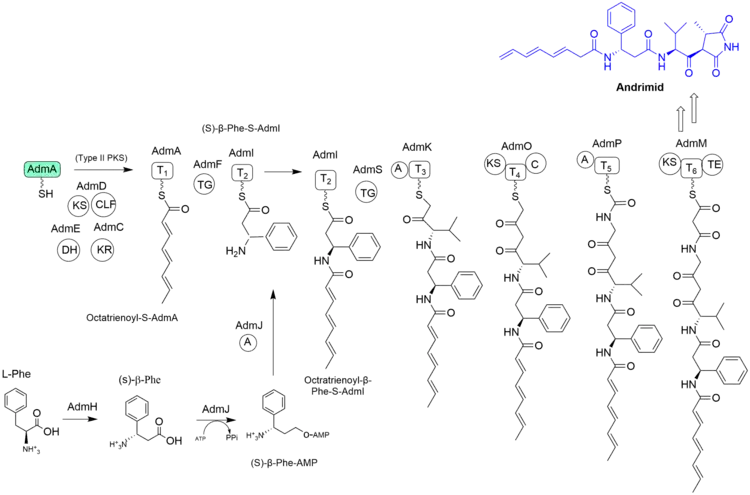Andrimid
Andrimid is an antibiotic natural product that is produced by the marine bacterium Vibrio coralliilyticus. Andrimid is an inhibitor of fatty acid biosynthesis by blocking the carboxyl transfer reaction of acetyl-CoA carboxylase (ACC).[1][2]
 | |
| Identifiers | |
|---|---|
| |
| CAS Number | |
| PubChem CID | |
| Chemical and physical data | |
| Formula | C27H33N3O5 |
| Molar mass | 479.6 g·mol−1 g·mol−1 |
| 3D model (JSmol) | |
| |
| |
| (verify) | |
Andrimid contains a pseudopeptide backbone and is synthesized through the polyketide synthase (PKS) and nonribosomal peptide synthetase (NRPS) pathways.[3][4] Amino acids are added by the NRPS pathway which loads amino acid monomer units into the growing chain during the molecular assembly line.[5][6]
Biosynthesis
Abbreviations: ketosynthase (KS), chain length factor (CLF), dehydrogenase (DH), ketoreductase (KR), thiolation (T), transglutaminase (TG), adenylation (A), condensation (C), thioesterase (TE).
Andrimid is derived from three amino acids which are phenylalanine, valine, and glycine. Phenylalanine is converted to its other conformation, while valine and glycine residues have been elongated by two carbons derived by malonyl units.[5] To incorporate the phenylalanine moiety into the biosynthesize of Andrimid, L-Phe must first be converted to (S)-β-Phe by the aminomutase AdmH. (S)-β-Phe reacts with ATP to active (S)-β-Phe-AMP by the A domain AdmJ which incorporates (S)-β-Phe onto the holo-AdmI(HS-AdmI), forming (S)-β-Phe-S-AdmI. AdmF catalyzes the formation of the octratrienoyl chain and the amine group of alpha-phenylalanine by acylation of its active site cysteine forming the Octratrienoyl-β-Phe-S-AdmI.[5] The hybrid biosynthesis goes through six T domains before final tailoring to form the natural product Andrimid. Additional characteristics of the Andrimid assembly line are the beginning enzymes such as AdmH containing the aminomutase, AdmJ containing the β-Phe adenylation (A) domain which serves as the gatekeepers of the biosynthesis for determining which aromatic amino acid is used by the transglutaminase homologue AdmF. AdmF uses acyl S-T domain and β-aminoacyl-S-T domain to form the amine bond. Furthermore, the three amino acid used in Andrimid are incorporated into the assembly line by AdmH and AdmJ. (S)-β-Phe is generated by AdmH and incorporated by AdmJ. As for the other two amino acids which are valine and glycine, they must first undergo an addition of two carbons by the PKS modules AdmO and AdmM. A total of five proteins are used for andrimid biosynthesis to create the chain initiation step which are AdmA, AdnI, AdnJ, AdmF, and AdmH.[5] During the PKS II pathway, malonyl-CoA is loaded onto the acyl carrier protein (ACP) which is transferred to the active site of ketosynthase (KS), releasing acetyl CoA to generate malonyl-CoA. This reaction undergoes chain elongation using malonyl-coenzyme A (CoA) following ketoreductase (CLF, DH, and KR). Note, the PKS II pathway is a systematic scheme, since there are not sufficient studies that demonstrate a clear route of the enzymes used for this chain elongation step of the fatty acid biosynthesis.[7][8]
References
- Matilla MA, Daddaoua A, Chini A, Morel B, Krell T (November 2018). "An auxin controls bacterial antibiotics production". Nucleic Acids Research. 46 (21): 11229–11238. doi:10.1093/nar/gky766. PMC 6265452. PMID 30500953.
- Liu X, Fortin PD, Walsh CT (September 2008). "Andrimid producers encode an acetyl-CoA carboxyltransferase subunit resistant to the action of the antibiotic". Proceedings of the National Academy of Sciences of the United States of America. 105 (36): 13321–13326. Bibcode:2008PNAS..10513321L. doi:10.1073/pnas.0806873105. PMC 2533188. PMID 18768797.
- Sun H, Liu Z, Zhao H, Ang EL (2015). "Recent advances in combinatorial biosynthesis for drug discovery". Drug Design, Development and Therapy. 9: 823–833. doi:10.2147/DDDT.S63023. PMC 4334309. PMID 25709407.
- Buijs Y, Isbrandt T, Zhang SD, Larsen TO, Gram L (2020). "The Antibiotic Andrimid Produced by Vibrio coralliilyticus Increases Expression of Biosynthetic Gene Clusters and Antibiotic Production in Photobacterium galatheae". Frontiers in Microbiology. 11: 622055. doi:10.3389/fmicb.2020.622055. PMC 7793655. PMID 33424823.
- Magarvey NA, Fortin PD, Thomas PM, Kelleher NL, Walsh CT (September 2008). "Gatekeeping versus promiscuity in the early stages of the andrimid biosynthetic assembly line". ACS Chemical Biology. 3 (9): 542–554. doi:10.1021/cb800085g. PMC 2728764. PMID 18652473.
- Fischbach MA, Lai JR, Roche ED, Walsh CT, Liu DR (July 2007). "Directed evolution can rapidly improve the activity of chimeric assembly-line enzymes". Proceedings of the National Academy of Sciences of the United States of America. 104 (29): 11951–11956. Bibcode:2007PNAS..10411951F. doi:10.1073/pnas.0705348104. PMC 1924594. PMID 17620609.
- Chen A, Re RN, Burkart MD (October 2018). "Type II fatty acid and polyketide synthases: deciphering protein-protein and protein-substrate interactions". Natural Product Reports. 35 (10): 1029–1045. doi:10.1039/c8np00040a. PMC 6233901. PMID 30046786.
- Zhang Z, Pan HX, Tang GL (2017). "New insights into bacterial type II polyketide biosynthesis". F1000Research. 6: 172. doi:10.12688/f1000research.10466.1. PMC 5321127. PMID 28299197.